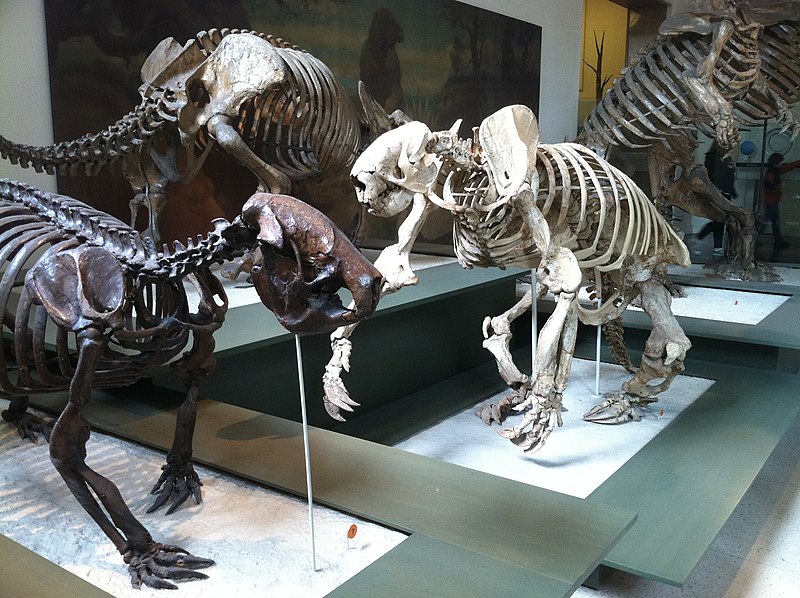Datei:Ground sloths.jpg

Originaldatei (2.592 × 1.936 Pixel, Dateigröße: 1,99 MB, MIME-Typ: image/jpeg)
Diese Datei stammt aus Wikimedia Commons und kann von anderen Projekten verwendet werden. Die Beschreibung von deren Dateibeschreibungsseite wird unten angezeigt.
Beschreibung
| BeschreibungGround sloths.jpg |
Foreground: Megalocnus rodens (left) from the Pleistocene of Cuba and Megalonyx wheatleyi (right) from the Pleistocene of the central and eastern US. Background: Scelidotherium cuvieri (left) and Glossotherium robustus (right) both from the Pleistocene of Argentina with Lestodon armatus behind it (you can see its ribcage), also from the Pleistocene of Argentina and a few surrounding nations. In the The Hall of Primitive Mammals at the American Museum of Natural History in New York. I like this exhibit. It demonstrates the huge diversity of giant ground sloths in the Pleistocene (2.58 mya to ~11,000 years ago), with highly divergent morphologies and life styles all across the New World. At the end of the Pleistocene however, humans invaded North and South America and everything changed. Suddenly, all ground sloths went extinct. Except of course, Megalocnus rodens of Cuba in the Caribbean, where they remained at least until around ~4,000 years ago. The first known human arrivals onto the island were around 5,000 years ago, long after the colonization of the mainland continents. For some reason these specimens were mounted in the Hall of Primitive Mammals (probably due to a lack of space in the Hall of Advanced Mammals, but it might also be due to the fact that they're xenarthrans, long thought of as basal placentals, although modern molecular data has challenged this view), but this is deceiving. If it were not for the environmental havoc and subsequent mass extinction at the end of the last ice age that humans almost certainly exacerbated, all of these massive beasts would be considered highly advanced megaherbivores of the modern realm. |
| Datum | |
| Quelle |
|
| Urheber | Dallas Krentzel |
| Kameraposition | 40° 46′ 51,35″ N, 73° 58′ 26,45″ W | Dieses und weitere Bilder auf OpenStreetMap |
|---|
Lizenz
- Dieses Werk darf von dir
- verbreitet werden – vervielfältigt, verbreitet und öffentlich zugänglich gemacht werden
- neu zusammengestellt werden – abgewandelt und bearbeitet werden
- Zu den folgenden Bedingungen:
- Namensnennung – Du musst angemessene Urheber- und Rechteangaben machen, einen Link zur Lizenz beifügen und angeben, ob Änderungen vorgenommen wurden. Diese Angaben dürfen in jeder angemessenen Art und Weise gemacht werden, allerdings nicht so, dass der Eindruck entsteht, der Lizenzgeber unterstütze gerade dich oder deine Nutzung besonders.
| Dieses Bild wurde ursprünglich auf Flickr veröffentlicht und am 21. Juli 2012 vom Administrator oder vertrauenswürdigen Benutzer File Upload Bot (Magnus Manske) überprüft. Die Überprüfung ergab, dass das Bild zum Zeitpunkt der Überprüfung auf Flickr mit der oben genannten Lizenz markiert war. |
Kurzbeschreibungen
In dieser Datei abgebildete Objekte
Motiv
Einige Werte ohne einen Wikidata-Eintrag
40°46'51.352"N, 73°58'26.454"W
14. Februar 2012
0.06666666666666666666 Sekunde
2,8
3,85 Millimeter
125
image/jpeg
Dateiversionen
Klicke auf einen Zeitpunkt, um diese Version zu laden.
| Version vom | Vorschaubild | Maße | Benutzer | Kommentar | |
|---|---|---|---|---|---|
| aktuell | 11:39, 21. Jul. 2012 |  | 2.592 × 1.936 (1,99 MB) | wikimediacommons>File Upload Bot (Magnus Manske) | Transferred from Flickr by User:FunkMonk using flickr2commons |
Dateiverwendung
Die folgende Seite verwendet diese Datei:
Metadaten
Diese Datei enthält weitere Informationen, die in der Regel von der Digitalkamera oder dem verwendeten Scanner stammen. Durch nachträgliche Bearbeitung der Originaldatei können einige Details verändert worden sein.
| Hersteller | Apple |
|---|---|
| Modell | iPhone 4 |
| Belichtungsdauer | 1/15 Sekunden (0,066666666666667) |
| Blende | f/2,8 |
| Film- oder Sensorempfindlichkeit (ISO) | 125 |
| Erfassungszeitpunkt | 13:59, 14. Feb. 2012 |
| Brennweite | 3,85 mm |
| Kameraausrichtung | Normal |
| Horizontale Auflösung | 72 dpi |
| Vertikale Auflösung | 72 dpi |
| Software | 5.0.1 |
| Speicherzeitpunkt | 13:59, 14. Feb. 2012 |
| Y und C Positionierung | Zentriert |
| Belichtungsprogramm | Standardprogramm |
| Exif-Version | 2.21 |
| Digitalisierungszeitpunkt | 13:59, 14. Feb. 2012 |
| Bedeutung einzelner Komponenten |
|
| APEX-Belichtungszeitwert | 3,9068906605923 |
| APEX-Blendenwert | 2,970853573907 |
| APEX-Helligkeitswert | 2,082100591716 |
| Messverfahren | Muster |
| Blitz | kein Blitz, Blitz abgeschaltet |
| unterstützte Flashpix-Version | 1 |
| Farbraum | sRGB |
| Messmethode | Ein-Chip-Farbsensor |
| Belichtungsmodus | Automatische Belichtung |
| Weißabgleich | Automatisch |
| Aufnahmeart | Standard |
| Schärfe | Stark |